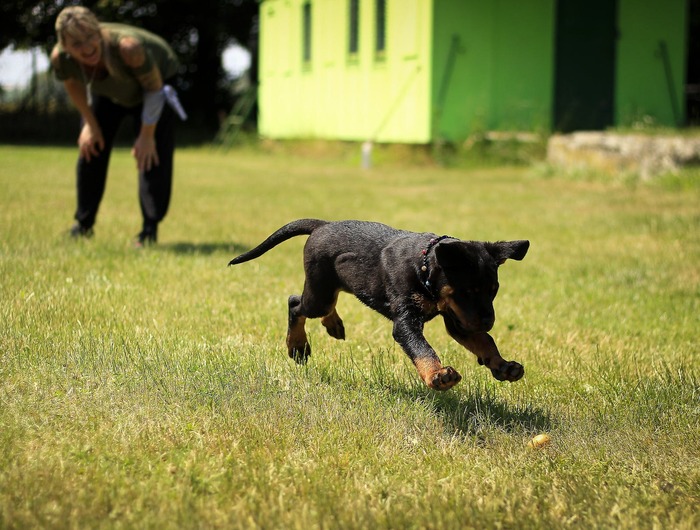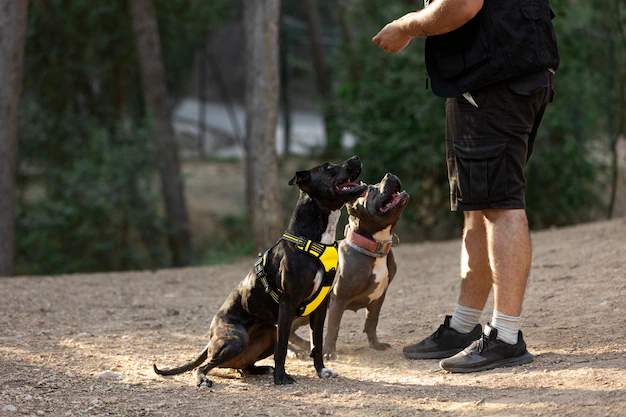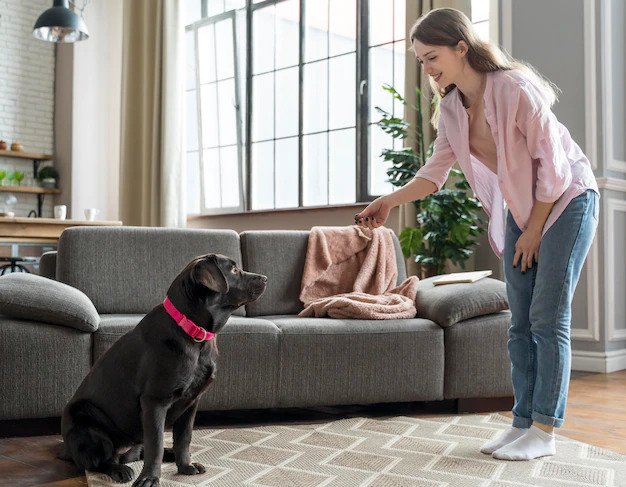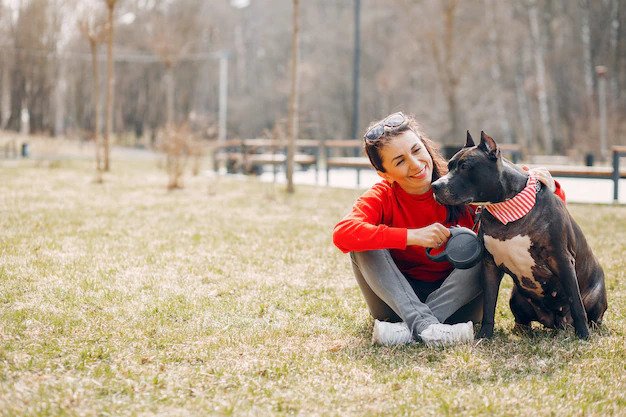2022-10-26
We have discussed many times how challenging raising and training a service dog is, but also how many benefits the presence of a service animal has for the physical and emotional state of his/her owner. Training a service dog is not an easy task, as it requires the dog to have skills beyond basic obedience. Service animals perform specific tasks, related to a disability, which makes them so unique and invaluable.
Today we talk about service dog training and how you can become a service dog trainer in particular.

The first step is to select the right dog for the job. In other words, you need to make a temperament evaluation.
There are various aspects of a pup’s personality that can help you determine whether the pup would be the right fit for the job or not.
Pups, who enjoy being around people, have a bigger potential to become good service dogs, as they might develop a strong bond with their owner. Being attuned to each other is essential for service dog teams that want to make great progress.
A puppy who tolerates physical contact and loves being petted is likely to be most suitable for the job than a pup, who does not enjoy physical contact. Physical contact is essential for certain types of service dog tasks such as tactile stimulation, deep pressure therapy, and balance tasks. Also, it will help you find the most appropriate training equipment for your dog.
In the ideal case, the pup should be friendly and enjoy interacting with people and animals, without showing strong dominance or submission tendencies. Too dominant dogs won’t be able to tolerate their owner to be the alpha and are not likely to perform the needed tasks without hesitation. Too submissive pups, on the other hand, might get easily afraid of other animals and people which will worsen their performance as service animals in public.
By audiovisual stimuli, we mean fast-moving objects and distinctive sounds, especially loud sounds, i.e. from fireworks. It is normal for a pup to show a reaction. However, pups with the greatest potential as service animals show interest in their surrounding without being anxious.
Similarly to the test in the previous point, you should look for a pup, who is showing interest in its surrounding, without being scared or overly emotional (although being overly emotional is common for some pups, and they manage to outgrow it).
Does the Puppy Have Tendencies to Retrieve?
You can throw a small object a few feet in front of you and encourage the pup to get it and bring it back to you. If you need a dog, who will retrieve objects for you, i.e. medication, pups who have the innate instinct to retrieve would be a great choice, i.e. the representatives of the Labrador/Golden Retriever, as the breed name implies. All these aspects, which are part of puppy testing, are included in the so-called Volhard Puppy Aptitude Test (PAT).

Determining What Tasks the Dog Will Be Trained to Perform
This is essential, especially if you are a dog owner, who wants to train their own service dog. It is important to note, that service dogs, regardless of how intelligent, trainable, friendly, and attached to their owner are, remain living beings with their limitations. It is not recommended that one service dog performs too many and too different tasks. A service dog should be trained to perform specific tasks, directly related to a disability and support one user.
Clearing up this question will help you narrow down the breeds that might be suitable for the needed tasks, i.e. small breeds are not a good fit for mobility/balance tasks, but can do a great job with PSD tasks; short-muzzled dog breeds are not a good choice for alert tasks, i.e. alert for low blood sugar or upcoming seizures, as those tasks are based on the excellent sense of smell dogs have. Long-muzzled breeds have many olfactory receptors.
Lifestyle and Breed-Specific Characteristics
Choosing a dog requires not only evaluation of the pup as an individual but making it clear whether the lifestyle of the user (who can also be the handler based on the local regulations) will suit the dog’s personality and temperament. Some breeds need a lot of time to exercise and walk, to stay mentally and physically fit. If you do not provide a pup of this type with the needed mental and physical stimulation, it can start showing unwanted behaviors. Another thing to consider is the dog’s size and whether it would be suitable to raise and train a service dog in an apartment or not. Levels of shedding, barking, drooling, tendencies to get along with small children, animals, and level of trainability are key factors for training to be successful.
Should You be Certified as a Dog / Service Dog Trainer?
There are no unified standards approved by the government that all trainers should meet to be “officially” recognized. Many trainers are self-taught and their reliability has proven throughout the years based on the positive experience their customers have. Many people rely on courses, seminars, videos, or books to receive the needed information on how to train a dog and a service dog in particular, and then they invest a lot of time to practice. Doing your own research, gaining information, and contacting already experienced trainers might be a good way, to begin with.
However, if you are looking for something more “official”, and by “official” we mean schools or organizations that have built a great reputation in this area, you may want to check Bergin University of Canine Studies. It is registered in Penngrove, California, United States, and offers degrees in canine-related businesses, human-canine relationships, and assistance dog partnerships at undergraduate and graduate levels.
Other options you might be interested in are the Association of Professional Dog Trainers (APDT) and the Certification Council of Professional Dog Trainers (CCPDT).
The APDT can help you find a reputable local dog trainer, or improve your skills and broaden your knowledge if you are already a dog trainer. The CCPDT is an independent certification and testing resource for dog training and behavioral professionals.
Once again, we will say that there is no official (government-approved) registry for service dogs and service dog trainers. There some websites that offer service dog registry as an option. However, registering without going though proper training is pointless and won’t guarantee you and your paw friend any access rights.

All service animals need to go through basic obedience training and advanced training, based on the specific tasks that dog will perform for the benefit of a person with a disability. Also, a Public Access Test (PAT) should be included- it verifies that the dog can manage various situations in public and remain calm and focused on his/her owner.
Basic obedience usually includes fundamental commands such as “sit”, “stay”, “come”, “down”, walking on a loose leash, and heel (“heel” means for a dog to walk by his/her owner’s side, usually the left side, at a distance no longer than 6 feet and be aligned with the owner’s hip). However, there is also extended obedience, that includes focus training (essential for service animals and their ability to remain focused on their owner), remaining quiet on command, swing finish (moving from a sit position to a heel position)...etc. Basic obedience should ensure that the dog will be well-mannered in public.
Advanced training is specific and depends on the person’s needs. There is variety of tasks that service dogs can be trained to perform and those can be related to both physical and mental disabilities, i.e.:
Mobility/Balance Tasks (pulling a wheelchair, assisting the owner to go up/down stairs, switch their position, stay on their feet...etc.);
Alert Tasks (alerting the owner about an oncoming seizure, anxiety episode, panic attack, cardiac episode, low/high blood sugar...etc.);
Guide Tasks (guiding the owner to a safe place, to a specific location, to the exit of a building, guiding the handler around hanging or moving objects...etc.);
Psychiatric Service Dog Tasks (Deep Pressure Therapy, tactile stimulation, grounding the handler, which means bringing them back to reality when an episode occurs, preventing repetitive harmful behaviors...etc.);
Retrieve Tasks (retrieving medication, beverages, a blanket, a phone, training equipment for walks...any item the handler may need during an episode or such that they can’t reach themselves due to physical inability).
Interactions with People (notifying a family member or a specific person that the owner needs help, giving money/credit card to cashier...etc.)
Advanced service dog tasks may vary based on the person’s needs.

We would say that it depends on the local regulations. You may or may not be allowed to train your own service dog. For example, owners in the UK and the US, are allowed to train their own service dogs which means that they are considered both users and handlers. Other countries require service dogs to have gone through training with a professional trainer / accredited school or even with members of Assistance Dogs International (ADI) or International Guide Dog Federation (IGDF), to be recognized as legitimate service animals.
This also depends on where you are based. We will use the examples listed above, namely the US and UK, where service dogs, known as assistance dogs in the UK, are not required to be certified.
Dog owners in the US and the UK are not required by law to put any identification gear on their service dogs. However, many service dog users/handlers consider identification gear such as an ID card, a vest, a harness, an ID tag...etc., helpful, as it indicates the status of the dog, namely that he/she is on duty and not a pet. This type of gear will indicate that dogs should not be distracted by passersby as any interactions with him/her would interfere with his/her ability to perform the trained service dog tasks. Also, identification gear is proof that the dog knows basic obedience and will behave properly in public places.